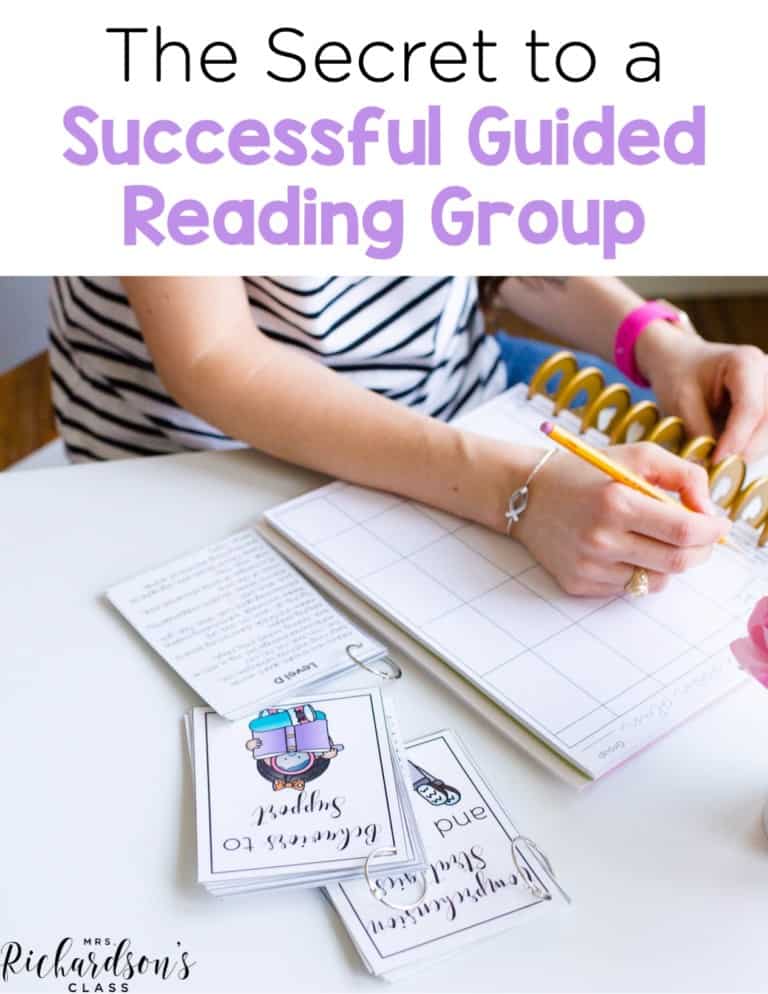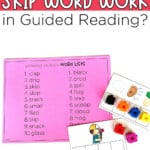

Have you started something with really good intentions, only to realize that you had to make some changes to your plan? Or maybe you were moving and grooving with something that seemed to be working really well until someone pointed out a flaw in your system? We’ve all been there, friend! With all of the latest research in reading, it’s time to make some changes to our guided reading routines.
But don’t worry…we can start with some small changes that lead to strong results. As teachers, we all want to see our students master important reading skills. This allows readers to enjoy books and learn from them. Those are the ultimate goals of reading. So let’s jump into four things we need to ditch in our guided reading routines.
One of the guided reading routines we need to switch up is how we prompt readers. Have you been taught to ask students to skip over words they can’t read or to look at the pictures? The most recent reading research suggests that this is not the best way to help our readers learn to read.
We want them to FIRST attend to the text. Visual should be the first cueing system they use. We want them to sound it out. We want them to decode the word the best that they can.
Then we want them to use meaning and syntax to cross-check. This is not always a one-and-done thing. They may sound it out, cross-check, go back to the word and sound it out, then cross-check again before they land on a word that is correct.
You can find FREE Guided Reading Prompting posters that align with this on my blog HERE!
One of the biggest things we need to rethink in guided reading is how we form guided reading groups. You may have been taught how to find guided reading levels through reading assessments, and then group students together based on guided reading levels. But guided reading groups can also be formed based on strategy needs.
If you have been working on a certain sound with a group or in your phonics instruction, you can use decodable readers for more practice. Decodable readers present the same sound in a variety of words in the text. This allows students have the opportunity to practice decoding that sound over and over. They are a great resource to think about and use when a group is struggling with a certain sound or phonics skill.
I know guided reading time often feels fast and furious, but we don’t want to keep the habit of skipping word work during guided reading lessons. It’s so important for young, developing readers to have practice manipulating sounds, letters, and words to build a strong foundation in reading.
If you find yourself regularly skipping word work due to running out of time, we need to brainstorm some solutions for you so that you can include it during your guided reading time. For example, try rearranging your guided reading schedule. You can also try changing up how long you’re spending in each element of the lesson. You can make word work come first in your plan. Finally, you can also shorten up some other elements to allow yourself more time for word work. I have a whole blog post dedicated to managing your guided reading lesson time HERE!
Finally, another one of the guided reading routines we need to ditch is introducing brand new phonics skills in guided reading. Instead, we want to introduce new phonics skills and concepts during our whole group or small group lessons. Then, you can use word work time for students to continue to practice those phonics skills.
There are so many different ways to include phonics practice into your guided reading lessons as a review and to reinforce learning. One phonics activity you can do is a word ladder. For example, if your phonics focus is the short /a/ sound, students will create a word ladder using short /a/ words.
You will repeat this with words with different beginning and ending sounds so students can practice manipulating letters to build a variety of short /a/ words. I have several more ways to practice this on my blog HERE.
If you’re wanting to start implementing some of these changes in your own guided reading routine but aren’t sure where to start, I have some FREE decodable guided reading passages that you can get started with.
Do you have some students that need more practice with decoding CVC? Put them in a strategy guided reading group and use a decodable passage. You can get them by entering your name and email below.
If you want decodable books, fully scripted guided reading lesson plans, and everything else you need to implement guided reading with decodable texts, I’ve got you covered. There are sets for short vowels, long vowels, blends, and digraphs or you can save and buy grabbing the bundle of all four sets. You can find them HERE!
I know change can be hard, especially when you already have so many things on your plate. It’s okay to start small by rethinking some of your guided reading routines and habits. Try starting with these four!

Want to use the latest research to boost your readers during small groups? This FREE guide is packed with engaging ideas to help them grow!

I’m a K-1 teacher who is passionate about making lessons your students love and that are easy to implement for teachers. Helping teachers like you navigate their way through their literacy block brings me great joy. I am a lifelong learner who loves staying on top of current literacy learning and practices. Here, you’ll find the tools you need to move your K-2 students forward!


| Cookie | Duration | Description |
|---|---|---|
| cookielawinfo-checkbox-analytics | 11 months | This cookie is set by GDPR Cookie Consent plugin. The cookie is used to store the user consent for the cookies in the category "Analytics". |
| cookielawinfo-checkbox-functional | 11 months | The cookie is set by GDPR cookie consent to record the user consent for the cookies in the category "Functional". |
| cookielawinfo-checkbox-necessary | 11 months | This cookie is set by GDPR Cookie Consent plugin. The cookies is used to store the user consent for the cookies in the category "Necessary". |
| cookielawinfo-checkbox-others | 11 months | This cookie is set by GDPR Cookie Consent plugin. The cookie is used to store the user consent for the cookies in the category "Other. |
| cookielawinfo-checkbox-performance | 11 months | This cookie is set by GDPR Cookie Consent plugin. The cookie is used to store the user consent for the cookies in the category "Performance". |
| viewed_cookie_policy | 11 months | The cookie is set by the GDPR Cookie Consent plugin and is used to store whether or not user has consented to the use of cookies. It does not store any personal data. |


